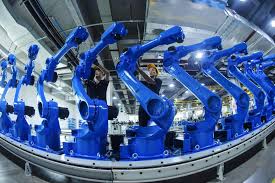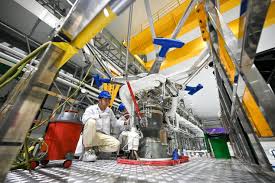Foreign
China’s meteorological early warning solutions benefit the world

By Li Hongmei, People’s Daily
In recent years, China’s meteorological authorities have actively forged a distinctive blueprint in weather crisis management through decades of operational refinement. What began as localized disaster preparedness efforts has evolved into a sophisticated national architecture – one that blends centralized governance with hyperlocal responsiveness. At its core lies an early warning paradigm balancing state coordination, predictive analytics, and grassroots mobilization, a model now gaining international attention as climate volatility intensifies.
Today, China’s early warning solutions have begun expanding globally through the establishment of operational platforms, provision of technical support, and implementation of personnel training programs, fostering international cooperation to jointly tackle the challenges of climate change.
The system’s global relevance emerges through its operational DNA: modular technical platforms adaptable to developing nations, knowledge-transfer programs cultivating meteorological expertise, and multilateral partnerships addressing shared climate threats. Yet its most compelling innovation remains the progressive meteorological forecasting and early warning service.
Developed through analyzing thousands of weather emergencies, this approach layers forecasts like meteorological Russian nesting dolls – broad probabilistic models gradually sharpening into neighborhood-specific alerts as storms approach. Each update tightens the geographic scope while escalating response protocols.
Operational rhythms shift palpably when danger looms. Emergency managers receive tiered notifications through redundant channels -phone calls, WeChat messages, and other channels. This graduated urgency system now blankets all provincial-level regions in China.
In recent years, China’s achievements in meteorological early warning stand as a testament to its relentless pursuit of scientific and technological excellence.
The nation has constructed the world’s most extensive integrated meteorological observation network, encompassing nine Fengyun meteorological satellites, 546 weather radars, and over 70,000 ground observation stations—a sprawling infrastructure that captures an unparalleled breadth of atmospheric data.
Three AI-powered forecasting models – “Fengqing,””Fenglei,” and “Fengshun”-have set benchmarks rivaling international leaders, harnessing computational power to predict weather phenomena with remarkable precision.
China’s intelligent digital grid forecasting systemboasts a nationwide spatial resolution of five kilometers, achieving a 93 percent accuracy rate for heavy rainfall warnings and providing a critical 43-minute lead time for severe convective weather alerts. Notably, the 24-hour typhoon track forecast maintains an average error margin of just 62 kilometers, placing it among the world’s most accurate.
Furthermore, China has established a warning information release system of national emergencythat integrates 82 types of alerts across 16 industries. This streamlined process ensures that critical warnings are disseminated to government officials, relevant departments, and industry stakeholders within a minute, enhancing rapid response and coordination.
Ko Barrett, deputy secretary-general of the World Meteorological Organization (WMO), has lauded China’s efforts in developing and building capacity for early warning systems, recognizing their significance as a model for global best practices.
China’s meteorological early warning systems and standards have garnered international recognition, now being adopted across multiple countries. The China Meteorological Administration (CMA) hasplayed a pivotal role in establishing a robust warning information dissemination system in Laos and launching an ASEAN data service platform dedicated to early warning operations.. Collaborating with the Pakistan Meteorological Department, China has developed a bespoke cloud-based early warning system that harnesses AI and other cutting-edge technologies for advancedweather forecasting.
Similar projects are unfolding with the Ethiopian meteorological authority and the Solomon Islands, where China is aiding in the development of cloud-based early warning systems and build platforms tailored to meet the needs of developing nations. Additionally, China leads a multi-hazard early warning system development initiative for Asia launched by the WMO.
China is also bolstering its global meteorological monitoring services. Its Fengyun satellites deliver over 100 types of data products and services to 132 countries and regions.Serving as on-duty satellites for the International Charter “Space and Major Disasters,” these satellites have generated more than 320 remote sensing monitoring reports, offering crucial support for disaster prevention, mitigation, and climate change-related early warnings worldwide.
In 2024, China hosted 25 training programs in fields such as meteorological AI, early warning, and satellite remote sensing applications, attracting 599 participants from 60 countries, both in-person and online.
Guided by the vision of building a community with a shared future for mankind, China is actively promoting its early warning solutions globally, collaborating with other nations to advance climate governance. This underscores China’s commitment as a responsible major country in the realm of meteorological and environmental stewardship.
At the 2024 Summit of the Forum on China-Africa Cooperation, convened in Beijing in September, the establishment of meteorological early warning systems was prominently featured among the ten partnership actions designed to propel modernization efforts between China and Africa.
In November of the same year, at the 29th session of the Conference of the Parties(COP29) to the United Nations Framework Convention on Climate Change (UNFCCC), China unveiledits Action Plan on Early Warning for Climate Change Adaptation (2025-2027). The plan delineates China’s dedication to bolstering early warning capabilities in other developing countries, equipping them with the tools necessary to adapt to the challenges posed by climate change.
China is also spearheading a South-South cooperation flagship project aimed at addressing climate change through tailored cloud-based early warning systems, developed in collaboration with developing nations in need.This comprehensive approach includes short-term training, specialized scholarships, and funding for long-term visiting scholarsfocused on early warning, risk assessment, and climate change adaptation. Such measures are intended to significantly enhance the capacity of these nations to manage climate risks and mitigate disaster impacts.
Jim Skea, chair of the Intergovernmental Panel on Climate Change (IPCC), has acknowledged China’s pivotal role on the international stage, emphasizing its indispensability in global climate governance. His recognition highlights the importance of China’s contributions to fostering a more resilient and adaptive world in the face of environmental challenges.
Foreign
China’s robot industry doubles revenue in five years

By Wang Zheng, Li Xinping, People’s Daily
At the 2025 China Robot Industry Development Conference, the China Machinery Industry Federation (CMIF) briefed on the performance of China’s robotics industry during the 14th Five-Year Plan period (2021-2025).
Industry revenue doubled from 106.1 billion yuan ($15 billion) in 2020 to 237.89 billion yuan in 2024. In the first three quarters of this year, revenue increased by 29.5 percent year on year.
Exports also expanded rapidly, growing from $390 million in 2020 to $1.15 billion in 2024. In the first three quarters of this year, exports reached $1.24 billion, surpassing last year’s total and marking a 56 percent year-on-year increase.
Domestic industrial robot brands gained significant market share, rising from 31.4 percent in 2020 to 58.5 percent in 2024.
“The robotics industry in China has grown rapidly during the 14th Five-Year Plan period, with a relatively complete industrial chain now in place,” said Xu Niansha, president of the CMIF.
Stronger Capabilities
At the 25th China International Industry Fair, Chinese industrial robot company Estun Automation showcased a heavy-duty robot capable of stably lifting and transporting 1,200 kilograms.
“Payload capacity is a key performance indicator. As industrial robots become increasingly integrated into manufacturing, demand is rising for high-rigidity, high-precision, and highly reliable heavy-duty models,” said a representative of Estun Automation.
Historically, China depended heavily on imported heavy-duty industrial robots, with domestic products accounting for less than 3 percent of the market. However, significant progress was achieved during the 14th Five-Year Plan period. For instance, Estun Automation’s 700-kilogram-capacity model, launched in 2024, received more than 100 orders, and in 2025, the company introduced a 1,000-kilogram-level robot.
Technological advances have also transformed welding, often referred to as the “sewing line” of modern industry. “Our welding robots deliver high-speed, heavy-load, highly stable spot welding. The fastest cycle for a single weld point is just 2.2 seconds,” said a representative of SIASUN Robot & Automation Co., Ltd., one of the largest robotics manufacturers in China.
Painting processes have similarly evolved. Traditional assembly lines typically require three to five days to paint a vehicle, whereas the automated production line using robots manufactured by Efort Intelligent Robot Co., Ltd. can complete the task in just over 80 seconds.
“This year’s new technologies allow robots to integrate intelligent process systems directly into the equipment, enabling automated color mixing, switching, spraying, and cleaning,” said engineer Wang Jinsong from Efort.
Stronger Industrial Support
In the first three quarters of this year, China’s industrial robot output reached 595,000 units, exceeding the total production of the previous year. This rapid growth reflects the continued development and strengthening of the country’s robotics industrial chain.
China has made significant advances in the production of core components, including high-precision reducers, high-performance servo systems, and intelligent controllers.
Harmonic reducers, often described as the “joints” of a robot, comprise a flexspline, wave generator, and circular spline. The flexspline, with a wall thickness of just 0.2 millimeters, requires micron-level machining precision. Chinese-made harmonic reducers now account for more than 40 percent of the domestic market.
Servo motors, the “muscles” of a robot, are essential for precise joint movement. Inovance Technology Co., Ltd., a leading global provider of industrial automation solutions based in Shenzhen, south China’s Guangdong province, holds the largest market share in China’s servo system sector.
At Inovance’s production base in Yueyang, central China’s Hunan province, the rotor production line has achieved full automation, while the stator line is 70 percent automated. “Our intelligent production lines deliver high precision and reliability, while also enabling customized services,” an Inovance representative said.
According to Song Xiaogang, executive vice chairman of the robotics branch of the CMIF, China’s robotics support system is becoming increasingly mature. Technological and industrial capacity has improved markedly, with leading robotics firms now producing over 80 percent of their components in-house.
Broader Applications
By the end of 2024, China was home to over 2 million industrial robots, ranking first globally.
In 2024, 302,000 industrial robots were sold in the Chinese market, marking an increase of 68.7 percent over 2020 and accounting for 54 percent of global sales.
The application of industrial robots has expanded significantly. By 2024, Chinese industrial robots had been deployed across 71 major categories and 241 sub-categories of the national economy, covering 51 percent of all sub-categories. This represents an increase of 19 major categories and 98 sub-categories compared with 2020.
Robot density in China’s manufacturing sector rose from eighth globally in 2020 to third in 2024.
The widespread integration of robotics has accelerated the development of intelligent manufacturing. China has established more than 35,000 basic-level intelligent factories, over 230 model factories, and 1,260 5G-enabled factories.
Looking ahead, intelligence and specialization are expected to drive future growth.
“As artificial intelligence becomes more deeply embedded in vertical industries, its integration with robotics is accelerating,” Song said, adding that robots are rapidly evolving from functional equipment performing repetitive, programmed tasks to intelligent partners capable of perception, decision-making, and autonomous action.
Foreign
Commercial spaceflight fuels China’s space exploration efforts

By Li Rui, People’s Daily
Recently, China sent a Gravity-1 carrier rocket into space from waters off the coast of Haiyang, east China’s Shandong province, placing three satellites into their designated orbits. This launch exemplifies the growing momentum of China’s emerging commercial space sector, which is contributing significantly to the country’s space exploration capabilities.
The global competition in commercial spaceflight is intensifying. According to projections, the scale of China’s commercial space market is expected to exceed 2.5 trillion yuan ($351.76 billion) this year. Through a strategic collaboration between the government and private enterprises, China is achieving a dynamic synergy that is accelerating technological advancements, reducing costs, and expanding the range of applications within its space industry. As a result, China’s space industry is gaining more visibility and vibrancy on the global stage.
China’s development of “space infrastructure” is advancing steadily, especially as the deployment of low-orbit satellite internet networks enters a phase of large-scale constellation expansion. However, the country faces a prominent challenge: the demand for satellite launches now exceeds the available capacity of traditional rockets. Relying solely on traditional rockets is far from sufficient to meet these growing needs.
In this context, the development of commercial space initiatives is essential to providing the necessary launch capacity for widespread space-based network deployment. This year, a new generation of commercial rockets, including the Zhuque-3, Tianlong-3, and Gravity-2, are advancing according to schedule with design, testing, and launch activities. These new launch vehicles will effectively alleviate the strain on satellite launch resources and bolster the development of China’s national satellite internet infrastructure.
Commercial spaceflight not only increases the frequency of launch opportunities but also opens up a broader range of technological possibilities. Unlike state-run space enterprises, private commercial companies are more agile and adaptable.
For example, the methalox engine independently developed by Chinese commercial rocket firm LandSpace has drawn global attention for its cost-effectiveness, clean propulsion, and reusability. Similarly, Chinese aerospace company Galactic Energy has significantly reduced rocket engine manufacturing costs through 3D printing.
Fueled by market-driven mechanisms and following a model of “small steps, rapid iterations,” commercial space enterprises have gained the favor of numerous research institutions. These companies serve as a strong complement to state-run space organizations, further advancing China’s space exploration capabilities.
As a dynamic sector driving the future of technological innovation, commercial spaceflight holds vast market potential. More than 10 provinces across China have introduced specific policies to support the development of the commercial space sector, fostering a wave of specialized and innovative companies focused on rocket development and satellite manufacturing. These initiatives have led to the creation of industrial clusters and a rapidly expanding “space economy” ecosystem.
For instance, Beijing is developing a regional industrial layout with rocket production in the south and satellite manufacturing in the north, while Shanghai aims to scale its space industry to hundreds of billions of yuan. Additionally, the aerospace industrial park Wuxi, east China’s Jiangsu province, has brought together more than 120 enterprises above the designated size, fueling growth and innovation.
As the commercial space sector shifts from isolated efforts to more integrated, clustered development, an autonomous, resilient, and competitive industrial ecosystem is taking shape, becoming a significant driver of economic growth and technological advancement in space.
Today, commercial spaceflight not only serves national missions but is also expanding its innovation to meet everyday needs. Applications such as satellite remote sensing allow farmers to manage irrigation systems via a mobile phone, while satellite internet provides broadband access to remote areas, including mountains and oceans. Moreover, satellite-enabled intelligent transportation systems are optimizing traffic signal timing to reduce congestion.
These innovations highlight how space technology, once perceived as distant and exclusive, is now becoming an integral part of everyday life, enhancing communications, supporting agriculture, improving mobility, and providing tangible benefits to the public.
Commercial spaceflight represents a vast frontier of opportunity. It is not only a scientific domain for exploring the unknown but also a burgeoning economic sector with boundless potential for the future.
Foreign
Forging new chapters in China-U.S. people-to-people friendship
By He Yin, People’s Daily
The 2025 Kuliang Forum, themed “Echoes of History,” was recently held in New York.
In this special year marking the 80th anniversary of the victory in the Chinese People’s War of Resistance Against Japanese Aggression and the World Anti-Fascist War, representatives from various sectors of China and the United States came together to commemorate the historical period when the two nations stood together in the fight for world peace.
Drawing on the legacy of Kuliang — an enduring symbol of China-U.S. people-to-people friendship — participants reaffirmed their commitment to strengthening mutual understanding and friendship.
The Kuliang story, personally promoted by Chinese President Xi Jinping, exemplifies the longstanding bond between the Chinese and American peoples. Xi has previously sent congratulatory letters to “Bond with Kuliang: 2023 China-U.S. People-to-People Friendship Forum” and to “Bond with Kuliang: 2024 China-U.S. Youth Festival,” underscoring the story’s continued relevance in today’s bilateral relations.
In recent years, “Kuliang Friends” and other supporters of China-U.S. friendship have actively preserved and promoted Kuliang’s legacy. Initiatives such as root-seeking visits and cultural exchanges, including “Bond with Kuliang: 2025 China-U.S. Youth Choir Festival,” have deepened mutual understanding and friendly exchanges between the two peoples.
The ever-growing and enduring Kuliang story shows that despite differences in history, culture, social systems, and development paths, the Chinese and American peoples share a common aspiration for friendship. This year, China held grand commemorative events marking the 80th anniversary of the victory in the Chinese People’s War of Resistance Against Japanese Aggression and the World Anti-Fascist War, inviting descendants of American Flying Tigers members to attend ceremonies atop Tian’anmen Gate.
At the seventh China-U.S. Sister Cities Conference, participants discussed “Closer Cooperation for a Sustainable Future.” During “Bond with Kuliang: 2025 China-U.S. Youth Choir Festival,” more than 1,000 young singers from both countries performed in celebration of friendship.
These acts of goodwill, though seemingly modest, accumulate to bridge the Pacific, turning a geographical divide into a conduit for cooperation. The hope of the China-U.S. relationship lies in the people, its foundation is in our societies, its future depends on the youth, and its vitality comes from exchanges at subnational levels.
In July this year, Xi replied to teachers and students of the U.S. youth pickleball cultural exchange delegation from Montgomery County, Maryland, who visited China under the initiative of inviting 50,000 young Americans to China for exchange and study programs in a five-year span.
Xi congratulated the delegation on its successful visit to China, expressing his hope that the delegation members will become a new generation of ambassadors for friendship between the two countries and make greater contributions to enhancing friendship between the two peoples.
Since the launch of the initiative of inviting 50,000 young Americans to China for exchange and study programs in a five-year span, participation has been enthusiastic, demonstrating the initiative’s strong appeal and profound influence. A wide range of activities under the initiative, including maker competitions, academic dialogues, “future diplomats” summer camps, choir and music festivals, and pickleball friendship matches, have deepened mutual understanding between Chinese and American youth. A recent poll in the United States indicates a steady improvement in American public perceptions of China, with younger generations increasingly serving as a driving force for bilateral friendship.
To write new chapters of the Kuliang story and deepen people-to-people affinity, China and the United States must work together to build platforms and broaden channels for exchanges.
Last month, Xi and his U.S. counterpart Donald Trump held a successful meeting in Busan, South Korea, providing strategic guidance and fresh momentum for the steady development of bilateral relations at a critical moment. The two presidents reached important consensus on advancing practical cooperation across various fields, including expanding people-to-people exchanges.
Since then, the China-U.S. relationship has generally maintained a steady and positive trajectory, and this is welcomed by the two countries and the broader international community. China welcomes more Americans to visit and experience a real, multidimensional, and comprehensive China. It is hoped that the U.S. side will work with China in the same direction and take active steps to facilitate people-to-people exchanges, thereby strengthening bilateral bonds and mutual understanding.
The achievements in China-U.S. relations are primarily attributable to the collective efforts of the people of the two countries, and the continued development of this relationship will rely even more on their support. Both sides should take the Kuliang bond as a link, people-to-people exchanges as a bridge, and youth friendship as a source of strength, working together to continue writing new chapters of China-U.S. friendship and contributing to the sound and steady growth of China-U.S. relations.
-

 Uncategorized5 years ago
Uncategorized5 years agoFG, states urged to harness flooding for ranching, others with technology – Agbaje
-

 Headlines10 years ago
Headlines10 years agoBreaking: EFCC seals Borno House of Assembly, as Hon members take to their heels
-

 News11 years ago
News11 years agoNigeria Security Operatives Stage Manhunt For Homosexual Perpetrator
-

 News9 years ago
News9 years agoHow 21-year-old Girl fled community over accusation of lesbianism
-

 News10 years ago
News10 years agoYobe Gov Moves Against Deputy
-

 Opinion7 years ago
Opinion7 years ago7 signs she has friend zoned you
-
Technology4 years ago
Online job placement company headhunts women
-

 Headlines10 years ago
Headlines10 years agoBorno Dep Gov Abducts Another Church Leader





